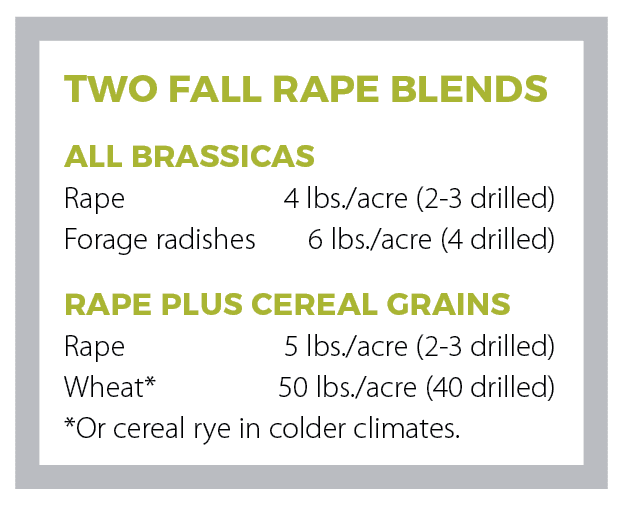The very first time I planted rape (Brassica napus) was in 2001 on a property that had a high deer density of 50 to 70 per square mile according to a trail-camera survey. To my surprise, deer used the plot sparingly throughout the fall and winter, as they spent most of their time foraging in the adjacent research plots that were planted in wheat, oats, cereal rye, crimson clover, berseem clover, winter peas, and many others. However, I’ve planted rape many times since then, on other properties within the same area, as well as different regions of the country and had much different results.
If you talk to deer managers across the country, this is a common scenario when planting brassicas, a forage family that includes rape, kale, turnips, radishes, and a few others. Some will tell you deer won’t touch brassicas while others can’t seem to keep deer off of it. Perhaps the variation in deer use of brassicas can be attributed to deer density and/or the availability of other forages. Others have suggested that deer need time to “discover” brassicas. Whatever the reason, the variability is real, and you really can’t predict how deer will use them on your property until you try it.
Species Description
Numerous varieties of rape exist. Some were developed for seed/oil production while others were developed for forage. Currently, rape is the most common brassica planted in food plots for deer, and it has many benefits.
Rape is a cool-season annual forage that is relatively quick to germinate. It is an extremely versatile forage and is adapted to a wide range of soil types and climatic conditions across the entire United States and Canada. Rape prefers well-drained, loamy soils, but it can be grown virtually anywhere. However, it does not do well on poorly drained sites that stay wet. Like most other food plot crops, it prefers a neutral soil pH in the 6 to 7 range.
Rape is very cold tolerant, which along with nutritional quality, is one of its greatest attributes as a deer forage. This allows it to provide quality forage during winter when many other species are less productive or dormant, particularly in the North. Overall palatability increases significantly after a couple frosts, which is typically the case for brassicas.
It is fairly drought tolerant and has good resistance to deer grazing. In well-managed plots, rape contains greater than 30 percent crude protein and approximately 15 percent acid detergent fiber, which means it is highly digestible and deer can utilize the nutrients efficiently. In fact, digestibility values determined for rape was the best of any deer forage tested in our research plots.
Forage rape is also highly productive as it can produce a large amount of forage in a short amount of time. In well-managed plots you can expect to produce 2 to 4 tons of quality forage per acre (dry weight). The pale green leaves are thick, fleshy and lobed and can reach about 12- to 18-inches tall, depending on soil fertility and planting density. It produces a small yellow flower in the spring.
Soil Preparation
Rape has high fertility requirements in order to maximize forage production, attraction, and nutritional quality. Soil testing should be conducted to determine how much lime and fertilizer is needed to make sure soil fertility and pH are in the desired range.
Phosphorus and potassium fertilizer should be applied according to levels recommended from a soil test. Adding nitrogen at 60 lbs./acre at planting and then again a couple months later will significantly increase production. If legumes like clover or winter peas are planted with rape, you can skip the second nitrogen application as the legumes will provide the additional nitrogen. It is also common for a soil test to recommend 1 to 2 lbs./acre of boron when planting brassicas as well.
With regard to preparing the seedbed for planting, be sure the planting surface is smooth and firm before broadcasting seed. This will promote optimal germination and growth, resulting in a healthier plot that can better withstand harsh weather conditions, diseases, grazing pressure, and weed pressure. If no-till planting (either drilling or top sowing), kill the existing vegetation with glyphosate a few weeks prior to planting to eliminate weed competition and create bare ground for good seed-to-soil contact.
Planting

I typically recommend planting rape alone or in mixtures with other brassicas as this allows for maximum forage production. Also, because rape develops fairly quickly with tons of leafy biomass, it can overcrowd and suppress lower growing or smaller forages. Thus, when mixing rape with other species, such as clovers and cereal grains, it is important to reduce the planting rate to 2 to 3 lbs./acre.
In the full species summary in Quality Whitetails magazine, I went into additional detail on specific weed control measures for forage rape. Become a QDMA supporter today and receive my complete profiles in future issues of the magazine.
Summary
Forage rape can provide several benefits in a diverse food plot program, especially during the winter when other forages may be less productive or dormant. As previously mentioned, if you’ve never planted rape (or other brassicas) on your property, it’s impossible to predict how deer will use it. You simply have to experiment with it to see how deer will respond. If deer don’t take to it the first time you plant it, be patient. It could prove to be irresistible the second time around.
